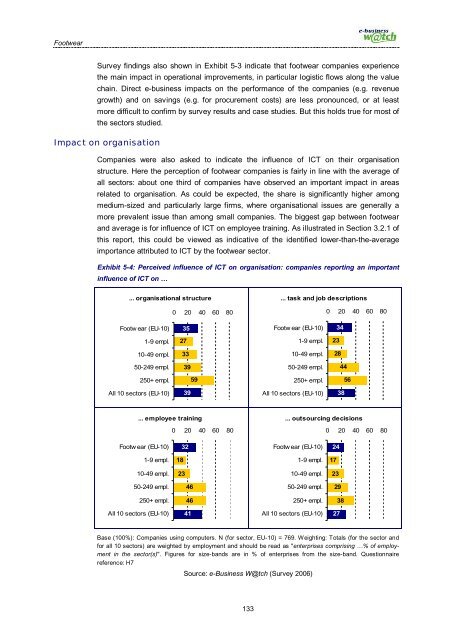Footwear Industry Footwear Industry - empirica
Footwear Industry Footwear Industry - empirica
Footwear Industry Footwear Industry - empirica
Create successful ePaper yourself
Turn your PDF publications into a flip-book with our unique Google optimized e-Paper software.
<strong>Footwear</strong><br />
Survey findings also shown in Exhibit 5-3 indicate that footwear companies experience<br />
the main impact in operational improvements, in particular logistic flows along the value<br />
chain. Direct e-business impacts on the performance of the companies (e.g. revenue<br />
growth) and on savings (e.g. for procurement costs) are less pronounced, or at least<br />
more difficult to confirm by survey results and case studies. But this holds true for most of<br />
the sectors studied.<br />
Impact on organisation<br />
Companies were also asked to indicate the influence of ICT on their organisation<br />
structure. Here the perception of footwear companies is fairly in line with the average of<br />
all sectors: about one third of companies have observed an important impact in areas<br />
related to organisation. As could be expected, the share is significantly higher among<br />
medium-sized and particularly large firms, where organisational issues are generally a<br />
more prevalent issue than among small companies. The biggest gap between footwear<br />
and average is for influence of ICT on employee training. As illustrated in Section 3.2.1 of<br />
this report, this could be viewed as indicative of the identified lower-than-the-average<br />
importance attributed to ICT by the footwear sector.<br />
Exhibit 5-4: Perceived influence of ICT on organisation: companies reporting an important<br />
influence of ICT on …<br />
... organisational structure<br />
0 20 40 60 80<br />
... task and job descriptions<br />
0 20 40 60 80<br />
<strong>Footwear</strong> (EU-10)<br />
35<br />
<strong>Footwear</strong> (EU-10)<br />
34<br />
1-9 empl.<br />
27<br />
1-9 empl.<br />
23<br />
10-49 empl.<br />
33<br />
10-49 empl.<br />
28<br />
50-249 empl.<br />
39<br />
50-249 empl.<br />
44<br />
250+ empl.<br />
59<br />
250+ empl.<br />
56<br />
All 10 sectors (EU-10)<br />
39<br />
All 10 sectors (EU-10)<br />
38<br />
... employee training<br />
0 20 40 60 80<br />
... outsourcing decisions<br />
0 20 40 60 80<br />
<strong>Footwear</strong> (EU-10)<br />
32<br />
<strong>Footwear</strong> (EU-10)<br />
24<br />
1-9 empl.<br />
18<br />
1-9 empl.<br />
17<br />
10-49 empl.<br />
23<br />
10-49 empl.<br />
23<br />
50-249 empl.<br />
46<br />
50-249 empl.<br />
29<br />
250+ empl.<br />
46<br />
250+ empl.<br />
38<br />
All 10 sectors (EU-10)<br />
41<br />
All 10 sectors (EU-10)<br />
27<br />
Base (100%): Companies using computers. N (for sector, EU-10) = 769. Weighting: Totals (for the sector and<br />
for all 10 sectors) are weighted by employment and should be read as "enterprises comprising …% of employment<br />
in the sector(s)". Figures for size-bands are in % of enterprises from the size-band. Questionnaire<br />
reference: H7<br />
Source: e-Business W@tch (Survey 2006)<br />
133

















